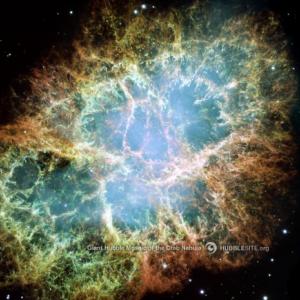College of Liberal Arts & Sciences
8B30.45 - Supernova and Novae
Video Credit: Jonathan M. Sullivan-Wood.
The "supernova spoof" is nothing more than an old fashioned flash bulb connected to a remote controlled relay. When looking at images of supernova the flash bulb hidden somewhere in the front of the lecture room can be triggered at an appropriate time.
- Travis Rector, Michelle Wooten, Andrew Puckett, Catherine Pilachowski, Kimberly Coble, "Searching for Stellar Explosions to Teach the Process of Science", TPT, Vol. 56, #7, Oct. 2018, p. 455.
- Rutger Dungan and Harrison B. Prosper, "Varying-G Cosmology with Type Ia Supernovae", AJP, Vol. 79, #1, Jan. 2011, p. 57.
- J. Craig Wheeler, "Resource Letter: OTS-1: Observations and Theory of Supernovae", AJP, Vol. 71, #1, Jan. 2003, p. 11.
- Alex Lopatka, "Elusive Helium Stars Indentified in Archival Data", Physics Today, Vol. 77, #2, Feb. 2024, p. 12.
- Alex Lopatka, "Magnetar-Powered Supernova", Physics Today, Vol. 73, #11, Nov. 2020, p. 64.
- Rachel Berkowitz, "Rare Nuclear Transition Provides Evidence for Stellar Explosion Mechanism", Physics Today, Vol. 73, # 3, March 2020, p. 16.
- Koji Mukai and Jennifer L. Sokoloski, "The New Science of Novae", Physics Today, Vol. 72, #11, Nov. 2019, p. 38.
- Andrew Grant, "A Baffling, Long-Lived Supernova", Physics Today, Vol. 71, #1, Jan. 2018, p. 21.
- Andrew Grant, "Superluminous Event May Lose Supernova Status", Physics Today, Vol. 70, #2, Feb. 2017, p. 23.
- Steven K. Blau, "The Most Energetic Supernova Conceivable", Physics Today, Vol. 69, #3, Mar. 2016, p. 14.
- R. Mark Wilson, "A Newly Found Pair of Stars Appears Destined to Merge and Explode", Physics Today, Vol. 68, #4, Apr. 2015, p. 15.
- "An Exploding Supermassive Star", Physics Today, Vol. 68, #1, Jan. 2015, p. 68.
- Bertram Schwarzschild, "X-ray Outburst Reveals A Supernova Before It Explodes", Physics Today, Vol. 61, #8, Aug. 2008, p. 21.
- Jennifer Leman, "Did Ancient Supernovae Change the Couse of Life on Earth?", Popular Mechanics, Jan. / Feb. 2022, p. 22.
- Daniel Clery, "Double Trouble", Science, Vol. 368, # 6495, June 5, 2020, p. 1046.
- Anders Jerkstrand, Keiichi Maeda, and Koji S. Kawabata, "A Type Ia Supernova at the Heart of Superluminous Transient SN 2006gy", Science, Vol. 367, #6476, Jan. 2020, p. 415.
- A. Goobar, R. Amanullah, S. R. Kulkarni, P. E. Nugent, J. Johansson, C. Steidel, D. Law, E. Mörtsell, R. Quimby, N. Blagorodnova, A. Brandeker, Y. Cao, A. Cooray, R. Ferretti, C. Fremling, L. Hangard, M. Kasliwal, T. Kupfer, R. Lunnan, F. Masci, A. A. Miller, H. Nayyeri, J. D. Neill, E. O. Ofek, S. Papadogiannakis, T. Petrushevska, V. Ravi, J. Sollerman, M. Sullivan, F. Taddia, R. Walters, D. Wilson, L. Yan, and O. Yaron, "iPTF16geu: A Multiply Imaged, Gravitationally Lensed Type Ia Supernova", Science, Vol. 356, #6335, Apr. 2017, p. 291.
- "Cosmic Particle Accelerators Identified", Science, Vol. 342, #6165, Dec. 2013, p. 1438.
- "This Month in Physics History: November 11, 1572: Tycho Brahe Spots a Supernova", APS News, Vol. 28, #10, Nov. 2019, p. 2, 3.
- Research News: Editors' Choice, "Infant Supernova Spotted", APS News, Vol. 26, #3, Mar. 2017, p. 1, 6.
- Curt Suplee, "We're the Stuff of Stars", Everyday Science Explained, National Geographic, p. 136 - 137.
- "Most Distant Observed Supernova", Guinness Book of World Records, 2003, p. 70.
Disclaimer: These demonstrations are provided only for illustrative use by persons affiliated with The University of Iowa and only under the direction of a trained instructor or physicist. The University of Iowa is not responsible for demonstrations performed by those using their own equipment or who choose to use this reference material for their own purpose. The demonstrations included here are within the public domain and can be found in materials contained in libraries, bookstores, and through electronic sources. Performing all or any portion of any of these demonstrations, with or without revisions not depicted here entails inherent risks. These risks include, without limitation, bodily injury (and possibly death), including risks to health that may be temporary or permanent and that may exacerbate a pre-existing medical condition; and property loss or damage. Anyone performing any part of these demonstrations, even with revisions, knowingly and voluntarily assumes all risks associated with them.
